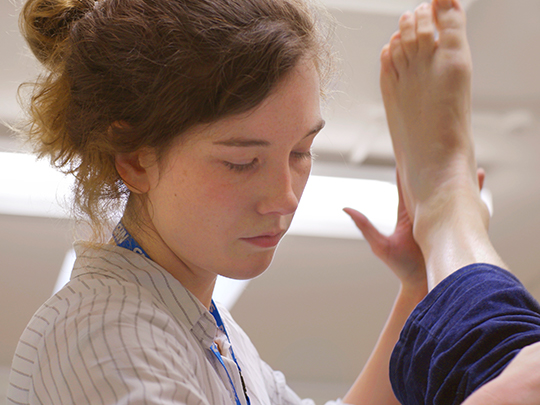
Kiara, Orthotist
Prosthetist and Orthotist
Prosthetists and Orthotists give back the power of movement to their patients, in a way that’s as pain-free as possible. They use the latest technology to create and fit prostheses or aids, in these diverse and exciting roles that demand hands-on skills along with both analytic and lateral thinking.
| Salary range | £24,000+ | |
| Hours | 37.5 hours a week | |
| Pattern | Shifts, with some evenings, nights and weekends |
![]() Prosthetist and Orthotist are shortage specialisms. Courses at English universities attract an additional £1,000 per year to study on top of the minimum £5,000 study grant. Learn more
Prosthetist and Orthotist are shortage specialisms. Courses at English universities attract an additional £1,000 per year to study on top of the minimum £5,000 study grant. Learn more
Role details
Prosthetists and Orthotists are quite different but require the same skills and qualities to give people back their ability to move well. Prosthetists create and fit artificial replacements for patients who’re missing a limb, while Orthotists correct problems or deformities in nerves, muscles and bones with a range of aids.
Problem-solving skills are vital, as getting the best performance out of a prosthesis or aid takes a lot of adjusting. What’s also key is the ability to build a rapport with people, as it’s not just about treating them physically but helping them feel happy with their blade or brace.
The roles may include:

Fitting a prosthesis for a military veteran, and seeing the full rehabilitation process.

Giving a surgeon your advice when they’re performing an amputation.

Helping a diverse range of ages, from children with cerebral palsy to adults with arthritis.

Preventing a patient from needing an amputation through well-fitting splints and complex footwear.
Qualities needed

A good communicator with the ability to build a rapport with people.

Comfortable with being hands-on with patients.

A problem-solver who can think laterally.

Have an interest in engineering and people.

Both technical and practical, you’re good at maths, and good with your hands.
“The best part of my job is the instant change that you can see you’re making in people’s lives.”
Kiara, Orthotist
What makes being a Prosthetist and Orthotist special?

You’ll help people return to their daily lives as pain-free as possible.

You’ll really get to know your patients, with lots of one-to-one care.

You’ll use the latest technology, such as computer-aided design and modelling, as well as blades and micro-processor knees.

Variety – every day is different. You’ll get to collaborate with a range of healthcare professionals, from Physios and Occupational Therapists to nurses and surgeons.
How to become a Prosthetist & Orthotist
To become a Prosthetist or Orthotist, you must first successfully complete an approved degree (BSc) in prosthetics and orthotics. It’s also possible to become a Prosthetist or Orthotist through an approved Apprenticeship.
Duration
3-4 years full-time
Once you’ve successfully completed your degree you must register with The Health and Care Professions Council (HCPC) before you can start practicing.
Entry requirements
- Two or three A levels, including maths, physics, biology/human biology or engineering
- Five GCSEs (grades A-C), including English language, maths and science. (Each institution sets its own entry requirements, so it’s important to check with them.)
- Equivalent qualifications:
- A BTEC, HND or HNC which includes maths or engineering
- A relevant NVQ
- A science-based access course
- Equivalent Scottish or Irish qualifications
- A previous degree or a full practicing qualification in a related area
Application period
There are opportunities to apply throughout the year, with September through to January being the busiest months. During February to October, UCAS Extra and Clearing applications are open, where universities look to fill in any course vacancies.
Keep in mind that individual universities may also set their own deadlines during this period.
Find a Prosthetics and Orthotics degree using the UCAS Course Finder
Apprenticeship
Training through an Apprenticeship is another way to become a Prosthetist or Orthotist. You’ll need to apply for an apprentice position with a healthcare provider.
Apprenticeships offer the opportunity to earn while gaining a qualification. Your employer and the government will pay the tuition fees for your apprenticeship, meaning apprenticeships are not eligible for student finance.
Vacancies can be found on the NHS Jobs website and Find an Apprenticeship website
and Find an Apprenticeship website

Gayle, Prosthetist
